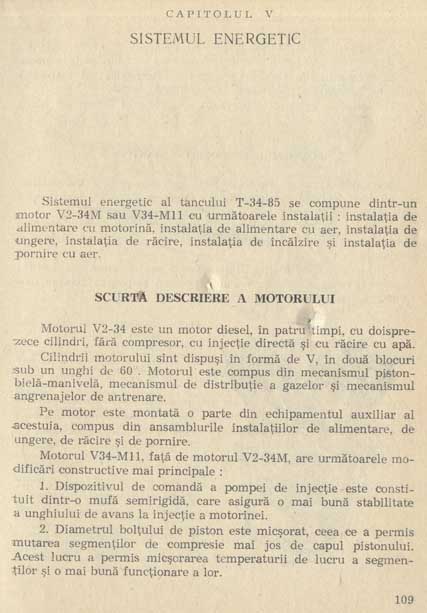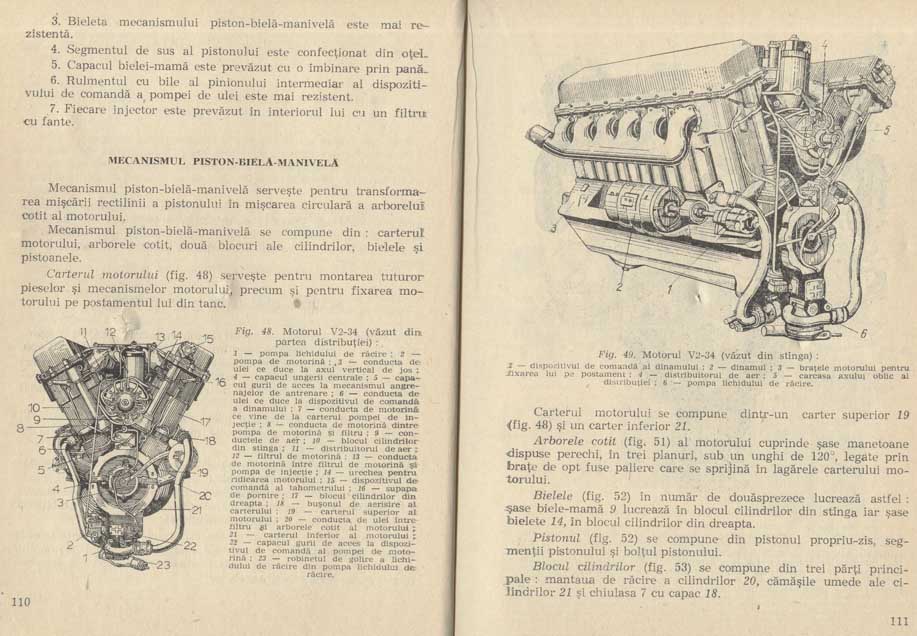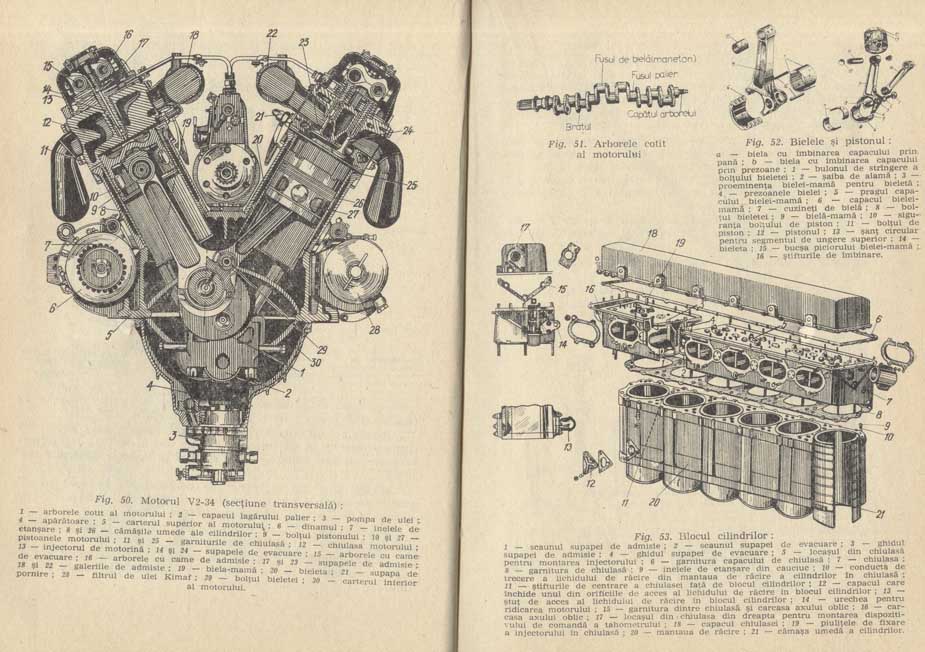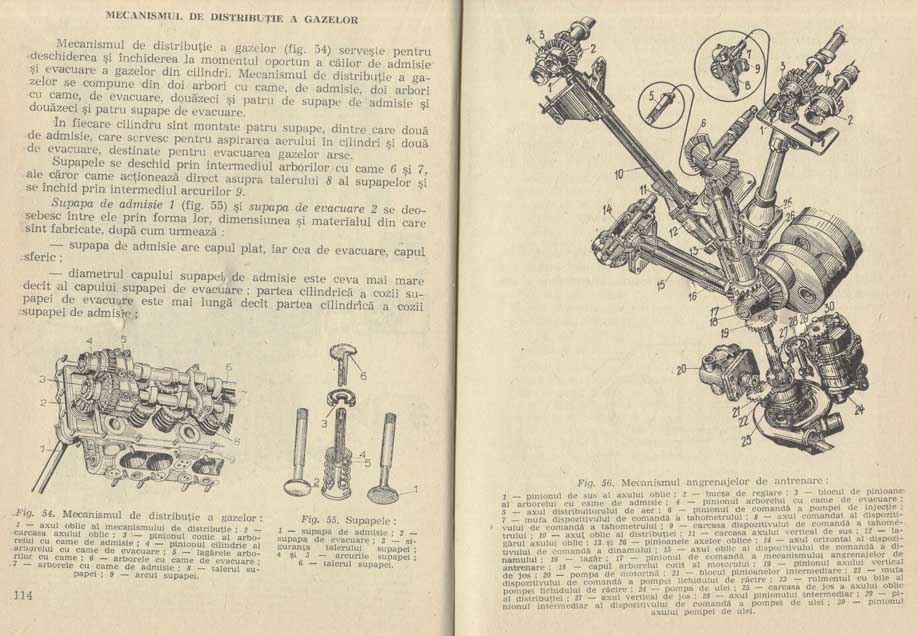 |  |  |
| Romanian Army in the Second World War · Forum Guidelines |
 Help Help
 Search Search
 Members Members
 Calendar Calendar
|
| Welcome Guest ( Log In | Register ) | Resend Validation Email |
| Pages: (2) [1] 2 ( Go to first unread post ) |    |
| Florin |
Posted: March 26, 2004 02:23 am
|
|
General de corp de armata Group: Members Posts: 1879 Member No.: 17 Joined: June 22, 2003 |
Hi,
Most of us here know about the famous Diesel motor of the T-34, with its 500 HP. That motor was famous for the usage of aluminum for the cylinder block. In a period when the turbo-compression feeding of cylinders was not yet developed for the Diesel motor, the usage of aluminum was the only way to make the motor with one ton (1000 kilograms) lighter. From another site I learned that the Germans simply could not afford to waste aluminum for tank motors, so they were forced to use all the war period the Otto type motor - with the more expensive and flammable gasoline. (The Germans even melted shut-down Allied bombers, for their needs of aluminum.) The Americans did not use Diesel motors for their tanks before the 60's, for the same problem of big weight, due to the big stress of the cylinders. My question is: The material used was pure aluminum, or an alloy of aluminum? Was the internal surface of the aluminum cylinder (the combustion chamber) coated with chrome? Or it was coated with something else? Or it was not coated? Any help, from anybody, appreciated. (With hope for the involvement of Mr. Miroslav Morozov.) And thank you in advance. |
| Dénes |
Posted: March 26, 2004 04:16 am
|
|
Admin Group: Admin Posts: 4368 Member No.: 4 Joined: June 17, 2003 |
If you won't find a meaningful reply here, I suggest to post your query on the following forum, called Russian Military Zone (RMZ):
http://www.network54.com/Hide/Forum/116312 However, beware of the pro-Communist (same class as pro-Nazi) tone some posters use, particularly a guy called Oleg (Sheremet). |
| Florin |
Posted: March 27, 2004 08:12 pm
|
|
General de corp de armata Group: Members Posts: 1879 Member No.: 17 Joined: June 22, 2003 |
As advised, I accessed
http://www.network54.com/Hide/Forum/116312 I did not get answer to my question, but the following are some interesting data from Oleg: Production of aluminum in millions of metric tons: Year - - Germany - - - USSR 1941 - - 233.6 - - - - 67.6 1942 - - 264.0 - - - -51.7 1943 - - 250.0 - - - -62.3 1944 - - 245.3 - - - -82.7 1945 - - N/A - - - - - -86.3 Total 1941-44 production: Germany -- 992.9, USSR -- 264.3. In addition, USSR received 237 million m.t. of aluminum via Lend Lease. The portion received in 1941-44 can be estimated at ~80% of that, or 190 mln m.t. Based on that, Germany used more than twice the amount of aluminum as USSR in 1941-44. |
| Dénes |
Posted: March 27, 2004 08:42 pm
|
|
Admin Group: Admin Posts: 4368 Member No.: 4 Joined: June 17, 2003 |
Just a point. Most German warplanes built in 1939-1942 were completely of metal (duralumin, electron), while most Soviet warplanes were of mixed plywood & canvas covering over metal (steel) structure. Later on, the Soviets also turned to all-metal construction.
|
| Florin |
Posted: March 28, 2004 12:48 am
|
|
General de corp de armata Group: Members Posts: 1879 Member No.: 17 Joined: June 22, 2003 |
The Russians used pine wood for some fighters, like versions of Yakloev.
About the German planes... there were some notable exceptions from the usage of aluminum, like the famous transport Ju-52, made from corrugated iron sheet. The hunger for aluminum of Germany is easy to be understood. Germany fought also with Soviet Union, while Soviet Union fought only with Germany (almost... |
| Diego |
Posted: May 01, 2004 07:27 pm
|
|
Soldat Group: Members Posts: 15 Member No.: 229 Joined: February 26, 2004 |
[quote]
... The Americans did not use Diesel motors for their tanks before the 60's, for the same problem of big weight, due to the big stress of the cylinders... [/quote] In fact some U.S. tanks during WWII were powered by diesel engines: M4A2 and M4A6 Sherman models used diesels, approximately 8000 being built, and some models of the M5 Stuart were diesel- powered. Most of these vehicles were provided to allies under the Lend- Lease program, or were used by the U.S. Marine Corps in the Pacific Theater. (Diesel fuel was readily available in the naval supply system, reducing the logistic problem of providing different fuels for different tank models.) Best, Diego |
| cuski |
Posted: May 03, 2004 09:24 pm
|
||
|
Fruntas Group: Members Posts: 85 Member No.: 85 Joined: August 21, 2003 |
Only 75 M4A6 Shermans were produced, and most of them remained in the US, in use with training units, as they proved to be of an inferior design. |
||
| Diego |
Posted: May 04, 2004 01:36 am
|
||
|
Soldat Group: Members Posts: 15 Member No.: 229 Joined: February 26, 2004 |
Quite true that only a small number of the M4A6 were produced, the newly designed Caterpillar diesel having significant development problems. For the M4A2 (powered by a General Motors diesel), Chamberlain and Ellis give a total production of 8053, while the "Standard Guide to U.S. WWII Tanks and Artillery" gives 9507 for total production. For the Lee/Grant series: 322 M3A3 and 591 M3A5, most of these sent to allies through Lend- Lease and a few used for U.S.M.C. training. For the Stuart series: 500 M3 with Guiberson diesels and 211 M3A1 with Guiberson diesels. Best, Diego |
||
| Florin |
Posted: May 06, 2004 03:27 am
|
|
General de corp de armata Group: Members Posts: 1879 Member No.: 17 Joined: June 22, 2003 |
It is nice to think the meaning of "only" through the mass production perspective.
From my memory: Germany produced along the whole war about 476 Tiger II, 1382 Tiger I, about 6000 Panzer IV, and about 3000 Panzer V (Panther). I say again: this is from memory. So from the American and Russian perspective of mass production, all these quantities are "only". |
| Robert |
Posted: October 04, 2004 03:04 am
|
|
Soldat Group: Members Posts: 27 Member No.: 361 Joined: October 02, 2004 |
I don't have my military history books with me, so I can't give you precise number of tanks produced with diesel engins. Besides the American M3's and M4's, I believe that the French FCM 36's also had diesel engins, as did a few other tanks built before and during W.W.II.
Diesel as a fuel for a tank engine does have a major advantage in that it does not become a vapor and explode in the way that gasoline does. The disadvantage to early diesel engins is (1) that they were much harder to start in cold weather than gasoline engines, and you had to let them warm up for a period of time (usually about 5 min.) after you had started them; and (2) they were not as responsive as gasoline engines. After all, if someone is firing at you, you want to be able to maneuver fast, and not wait for the lag in in the engine's response time. |
| MAB38 |
Posted: November 30, 2004 05:41 pm
|
|
Soldat Group: Members Posts: 29 Member No.: 382 Joined: November 08, 2004 |
Italian medium tanks M39 and M40 used Ansaldo diesel engines. The light tank L33 (known to soldiers as "scatola da sardine", sardine tin) had a petrol engine.
Most italian army trucks were also diesel powered, due to the longer life and lower fuel consumption of these power units. Fuel saving was very imposrtant for a country like Italy that had no oil resourec of its own. In fact after the war the Italian military got quickly rid of lots of ex allied petrol engined road vehicles that had been passed on to them after the country changed sides in 1943, because of the high maintenance and fuel costs. |
| dragos |
Posted: November 30, 2004 08:33 pm
|
 Admin Group: Admin Posts: 2397 Member No.: 2 Joined: February 11, 2003 |
Here is the best information I have found about the T-34 engine (unfortunatelly nothing about the alloys composition of the cylinders)
Attached Image  |
| dragos |
Posted: November 30, 2004 08:34 pm
|
 Admin Group: Admin Posts: 2397 Member No.: 2 Joined: February 11, 2003 |
...
Attached Image  |
| dragos |
Posted: November 30, 2004 08:34 pm
|
 Admin Group: Admin Posts: 2397 Member No.: 2 Joined: February 11, 2003 |
...
Attached Image  |
| dragos |
Posted: November 30, 2004 08:35 pm
|
 Admin Group: Admin Posts: 2397 Member No.: 2 Joined: February 11, 2003 |
...
Attached Image  |
1 User(s) are reading this topic (1 Guests and 0 Anonymous Users)
0 Members:
 Pages: (2) [1] 2
Pages: (2) [1] 2 |
   |
[ Script Execution time: 0.0082 ] [ 14 queries used ] [ GZIP Enabled ]
Powered by Invision Power Board(U) v1.3.1 Final © 2003 IPS, Inc.






